Field Study on the Microclimate of Public Spaces in Traditional Residential Areas in a Severe Cold Region of China
Abstract
:1. Introduction
2. Methods
2.1. Study Area and Monitoring Sites
2.2. Monitoring Instruments
2.3. Admeasurement and Calculation of Research Elements
3. Results
3.1. Influence of Orientation and the Green Coverage Ratio on the Street Microclimate
3.1.1. Street Orientation
3.1.2. Green Coverage Ratio
3.2. Influence of the Sky View Factor on the Courtyard Microclimate
3.3. Microclimate Differences between Streets and Courtyards
4. Discussion
5. Conclusions
Author Contributions
Funding
Acknowledgments
Conflicts of Interest
References
- Santamouris, M. Cooling the cities—A review of reflective and green roof mitigation technologies to fight heat island and improve comfort in urban environments. Sol. Energy. 2014, 103, 682–703. [Google Scholar] [CrossRef]
- Xu, L.Y.; Xie, X.D.; Li, S. Correlation analysis of the urban heat island effect and the spatial and temporal distribution of atmospheric particulates using TM images in Beijing. Environ. Pollut. 2013, 178, 102–114. [Google Scholar] [CrossRef] [PubMed]
- Rosenfeld, A.H.; Akbari, H.; Bretz, S.; Fishman, B.L.; Kurn, D.M.; Sailor, D.; Taha, H. Mitigation of urban heat islands: Materials, utility programs, updates. Energy. Build. 1995, 22, 255–265. [Google Scholar] [CrossRef]
- Santamouris, M.; Papanikolaou, N.; Livada, I.; Koronakis, I.; Georgakis, C.; Argiriou, A.; Assimakopoulos, D.N. On the impact of urban climate on the energy consumption of buildings. Solar. Sol. Energy. 2001, 70, 201–216. [Google Scholar] [CrossRef]
- Oke, T.R. Boundary layer climates. Earth-Sci. Rev. 1987, 27, 265. [Google Scholar] [CrossRef]
- Shafaghat, A.; Keyvanfar, A.; Manteghi, G.; Lamit, H.B. Environmental-conscious factors affecting street microclimate and individuals’ respiratory health in tropical coastal cities. Sust. Cities. Soc. 2016, 21, 35–50. [Google Scholar] [CrossRef]
- Hami, A.; Abdi, B.; Zarehaghi, D.; Maulan, S.B. Assessing the thermal comfort effects of green spaces: A systematic review of methods, parameters, and plants’ attributes. Sust. Cities. Soc. 2019. [Google Scholar] [CrossRef]
- Cui, D.; Hu, G.; Ai, Z.; Du, Y.; Mak, C.M.; Kwok, K. Particle image velocimetry measurement and CFD simulation of pedestrian level wind environment around U-type street canyon. Build. Environ. 2019, 154, 239–251. [Google Scholar] [CrossRef]
- Emmanuel, R.; Rosenlund, H.; Johansson, E. Urban shading—a design option for the tropics? a study in colombo, srilanka. Int. J. Climatol. 2007, 27, 1995–2004. [Google Scholar] [CrossRef]
- Pearlmutter, D.; Berliner, P.; Shaviv, E. Physical modeling of pedestrian energy exchange within the urban canopy. Build. Environ. 2006, 41, 783–795. [Google Scholar] [CrossRef]
- Bourbia, F.; Awbi, H.B. Building cluster and shading in urban canyon for hot dry climate: Part 2: Shading simulations. Renew. Energy. 2004, 29, 291–301. [Google Scholar] [CrossRef]
- Shashua-Bar, L.; Tzamir, Y.; Hoffman, M.E. Thermal effects of building geometry and spacing on the urban canopy layer microclimate in a hot-humid climate in summer. Int. J. Climatol. 2004, 24, 1729–1742. [Google Scholar] [CrossRef]
- Shashua-Bar, L.; Hoffman, M.E.; Tzamir, Y. Integrated thermal effects of generic built forms and vegetation on the UCL microclimate. Build. Environ. 2006, 41, 343–354. [Google Scholar] [CrossRef]
- Mohajeri, N.; Gudmundsson, A.; Kunckler, T.; Upadhyay, G.; Assouline, D.; Kämpf, J.; Scartezzini, J.L. A solar-based sustainable urban design: The effects of city-scale street-canyon geometry on solar access in Geneva, Switzerland. Appl. Energy. 2019, 240, 173–190. [Google Scholar] [CrossRef]
- Chatzidimitriou, A.; Yannas, S. Street canyon design and improvement potential for urban open spaces; the influence of canyon aspect ratio and orientation on microclimate and outdoor comfort. Sust. Cities. Soc. 2017, 33, 85–101. [Google Scholar] [CrossRef]
- Sözen, İ.; Koçlar Oral, G. Outdoor thermal comfort in urban canyon and courtyard in hot arid climate: A parametric study based on the vernacular settlement of Mardin. Sust. Cities. Soc. 2018. [Google Scholar] [CrossRef]
- Ali-Toudert, F.; Mayer, H. Numerical study on the effects of aspect ratio and orientation of an urban street canyon on outdoor thermal comfort in hot and dry climate. Build. Environ. 2006, 41, 94–108. [Google Scholar] [CrossRef]
- Ali-Toudert, F.; Mayer, H. Effects of asymmetry, galleries, overhanging façades and vegetation on thermal comfort in urban street canyons. Sol. Energy. 2007, 81, 742–754. [Google Scholar] [CrossRef]
- Lee, S.-H.; Lee, H.; Park, S.-B.; Woo, J.-W.; Lee, D.-I.; Baik, J.-J. Impacts of in-canyon vegetation and canyon aspect ratio on the thermal environment of street canyons: Numerical investigation using a coupled WRF-VUCM model. Q. J. R. Meteorol. Soc. 2016, 699, 2562. [Google Scholar] [CrossRef]
- Srivanit, M.; Hokao, K. Evaluating the cooling effects of greening for improving the outdoor thermal environment at an institutional campus in the summer. Build. Environ. 2013, 66, 158–172. [Google Scholar] [CrossRef]
- Zheng, S.; Guldmann, J.-M.; Liu, Z.; Zhao, L. Influence of trees on the outdoor thermal environment in subtropical areas: An experimental study in Guangzhou, China. Sust. Cities. Soc. 2018, 42, 482–497. [Google Scholar] [CrossRef]
- Shashua-Bar, L.; Pearlmutter, D.; Erell, E. The cooling efficiency of urban landscape strategies in a hot dry climate. Landsc. Urban. Plan. 2009, 92, 179–186. [Google Scholar] [CrossRef]
- Bradley, G.A. Urban forest landscapes: Integrating multidisciplinary perspectives. J. Am. Plann. Assoc. 1995. Available online: http://search.ebscohost.com/login.aspx?direct=true&db=edsbvb&AN=edsbvb.BV010403231&lang=zh-cn&site=eds-live (accessed on 1 August 2019).
- Steven, V. Drag and reconfiguration of broad leaves in high winds. J. Exp. Bot. 1989, 40, 941. [Google Scholar]
- Yuan, C.; Norford, L.; Ng, E. A semi-empirical model for the effect of trees on the urban wind environment. Landsc. Urban. Plan. 2017, 168, 84–93. [Google Scholar] [CrossRef]
- Guedouh, M.S.; Zemmouri, N.; Hanafi, A.; Qaoud, R. Passive strategy based on courtyard building morphology impact on thermal and luminous environments in hot and arid region. Energy. Procedia. 2019, 157, 435–442. [Google Scholar] [CrossRef]
- Rodríguez-Algeciras, J.; Tablada, A.; Chaos-Years, M.; De la Paz, G.; Matzarakis, A. Influence of aspect ratio and orientation on large courtyard thermal conditions in the historical centre of Camagüey-Cuba. Renew. Energy. 2018, 125, 840–856. [Google Scholar] [CrossRef]
- Nasrollahi, N.; Hatami, M.; Khastar, S.R.; Taleghani, M. Numerical evaluation of thermal comfort in traditional courtyards to develop new microclimate design in a hot and dry climate. Sust. Cities. Soc. 2017, 449. [Google Scholar] [CrossRef]
- Berkovic, S.; Yezioro, A.; Bitan, A. Study of thermal comfort in courtyards in a hot arid climate. Sol. Energy. 2012, 86, 1173–1186. [Google Scholar] [CrossRef]
- Shashua-Bar, L.; Pearlmutter, D.; Erell, E. The influence of trees and grass on outdoor thermal comfort in a hot-arid environment. Int. J. Climatol. 2011, 10, 1498. [Google Scholar] [CrossRef]
- Watanabe, S.; Nagano, K.; Ishii, J.; Horikoshi, T. Evaluation of outdoor thermal comfort in sunlight, building shade, and pergola shade during summer in a humid subtropical region. Build. Environ. 2014, 82, 556–565. [Google Scholar] [CrossRef]
- Muhaisen, A.S.; Gadi, M.B. Effect of courtyard proportions on solar heat gain and energy requirement in the temperate climate of Rome. Build. Environ. 2006, 41, 245–253. [Google Scholar] [CrossRef]
- Oke, T.R. Canyon geometry and the nocturnal urban heat island: Comparison of scale model and field observations. Int. J. Climatol. 1981, 1, 237–254. [Google Scholar] [CrossRef]
- Correa, E.; Ruiz, M.A.; Canton, A.; Lesino, G. Thermal comfort in forested urban canyons of low building density. An assessment for the city of Mendoza. Argentina. Build. Environ. 2012, 58, 219–230. [Google Scholar] [CrossRef]
- Chudnovsky, A.; Ben-Dor, E.; Saaroni, H. Diurnal thermal behavior of selected urban objects using remote sensing measurements. Energy. Build. 2004, 36, 1063–1074. [Google Scholar] [CrossRef]
- Yamashita, S.; Sekine, K.; Shoda, M.; Yamashita, K.; Hara, Y. On relationships between heat island and sky view factor in the cities of Tama River basin, Japan. Atmos. Environ. 1986, 20, 681–686. [Google Scholar] [CrossRef]
- Unger, J. Intra-urban relationship between surface geometry and urban heat island: Review and new approach. Clim. Res. 2004, 27, 253. [Google Scholar] [CrossRef]
- Johnson, D.B. Urban modification of diurnal temperature cycles in Birmingham, U.K. Int. J. Climatol. 1985, 5, 221–225. [Google Scholar] [CrossRef]
- Svensson, M.K. Sky view factor analysis—implications for urban air temperature differences. Clim. Res. 2010, 11, 201–211. [Google Scholar] [CrossRef]
- Johansson, E. Influence of urban geometry on outdoor thermal comfort in a hot dry climate: A study in Fez, Morocco. Build. Environ. 2006, 41, 1326–1338. [Google Scholar] [CrossRef]
- Chatzipoulka, C.; Compagnon, R.; Kaempf, J.; Nikolopoulou, M. Sky view factor as predictor of solar availability on building façades. Sol. Energy. 2018, 170, 1026–1038. [Google Scholar] [CrossRef]
- Ahmadi Venhari, A.; Tenpierik, M.; Taleghani, M. The role of sky view factor and urban street greenery in human thermal comfort and heat stress in a desert climate. J. Arid. Environ. 2019, 166, 68–76. [Google Scholar] [CrossRef]
- Yang, F.; Qian, F.; Lau, S.S.Y. Urban form and density as indicators for summertime outdoor ventilation potential: A case study on high-rise housing in Shanghai. Build. Environ. 2013, 70, 122–137. [Google Scholar] [CrossRef]
- Xu, S. Research on the Influence of Urban Road Network on the Wind Environment of Road in Harbin in Winter. Master’s Thesis, Harbin Institute of Technology, Harbin, China, 2018. [Google Scholar]
- Jin, H.; Liu, S.; Kang, J. The thermal comfort of urban pedestrian street in the severe cold area of Northeast China. Energy. Procedia. 2017, 134, 741–748. [Google Scholar] [CrossRef]
- Jin, H.; Liu, S.; Kang, J. Thermal comfort range and influence factor of urban pedestrian streets in severe cold regions. Energy. Build. 2019, 198, 197–206. [Google Scholar] [CrossRef]
- Jin, Y.; Kang, J.; Jin, H. Thermal environment of old residential streets in Harbin in winter. Build. Sci. 2016, 32, 34–38. [Google Scholar] [CrossRef]
- Jin, H.; Lv, H.; Lin, Y. Influence of vegetation structures on winter and summer microclimates of urban residential areas in severe cold region. Landsc. Archit. 2018, 25, 14–17. [Google Scholar] [CrossRef]
- Dimoudi, A.; Kantzioura, A.; Zoras, S.; Pallas, C.; Kosmopoulos, P. Investigation of urban microclimate parameters in an urban center. Energy. Build. 2013, 64, 1–9. [Google Scholar] [CrossRef]
- Akbari, H.; Matthewind speed, H.D. Global cooling updates: Reflective roofs and pavements. Energy. Build. 2012, 55, 2–6. [Google Scholar] [CrossRef]
- Taha, H. Urban climates and heat islands: Albedo, evapotranspiration, and anthropogenic heat. Energy Build. 1997, 2, 99. [Google Scholar] [CrossRef]
- Sailor, D.J. A review of methods for estimating anthropogenic heat and moisture emissions in the urban environment. Int. J. Climatol. 2011, 31, 189–199. [Google Scholar] [CrossRef]
- Yokobori, T.; Ohta, S. Effect of land cover on air temperatures involved in the development of an intra-urban heat island. Clim. Res. 2009, 39, 61–73. [Google Scholar] [CrossRef]
- Eduardo, K.; Givoni, B. Outdoor measurements and temperature comparisons of seven monitoring stations: Preliminary studies in curitiba, brazil. Build. Environ. 2007, 42, 1685–1698. [Google Scholar] [CrossRef]
- Zhang, L.; Zhan, Q.; Lan, Y. Effects of the tree distribution and species on outdoor environment conditions in a hot summer and cold winter zone: A case study in Wuhan residential quarters. Build. Environ. 2018, 130, 27–39. [Google Scholar] [CrossRef]
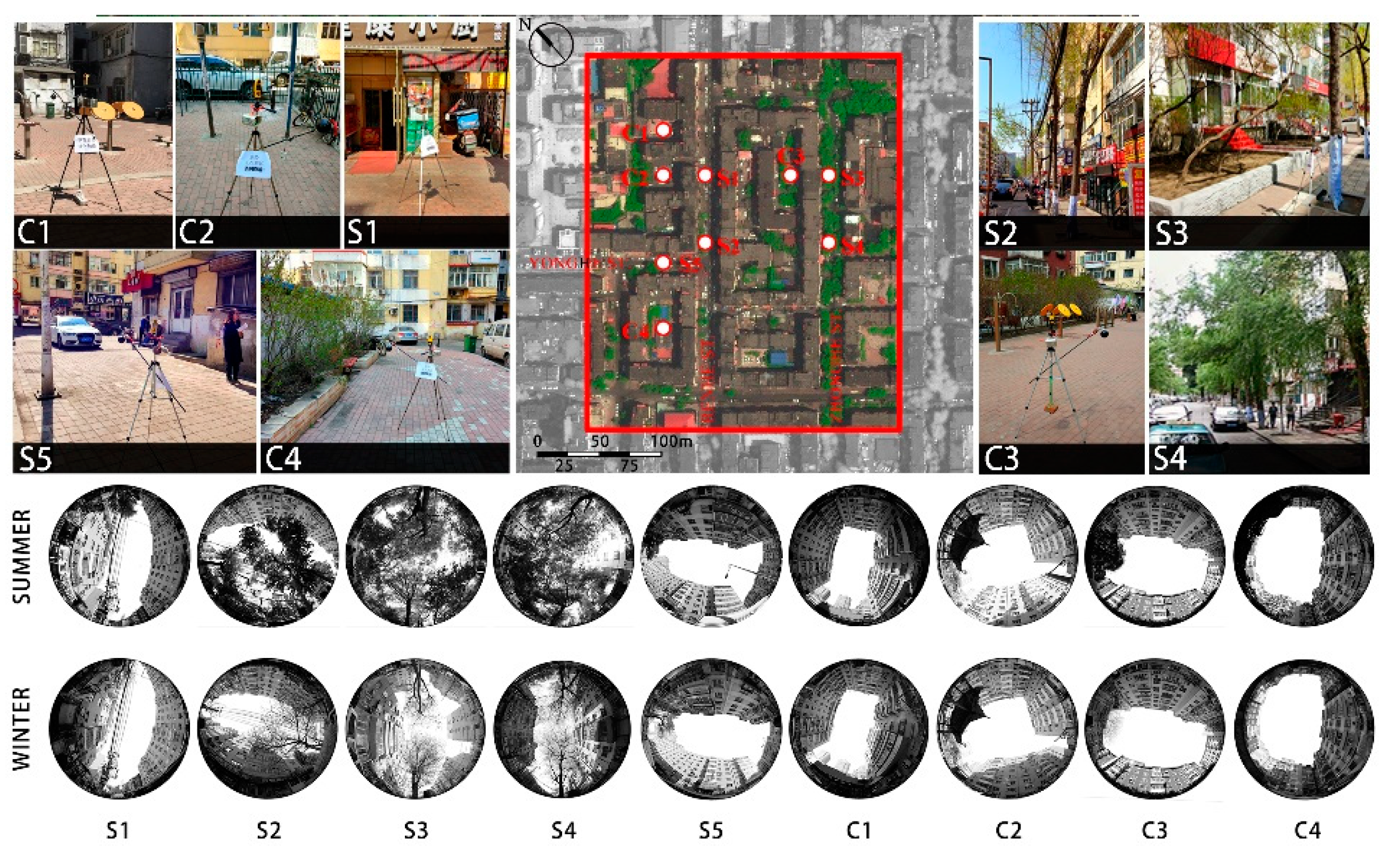
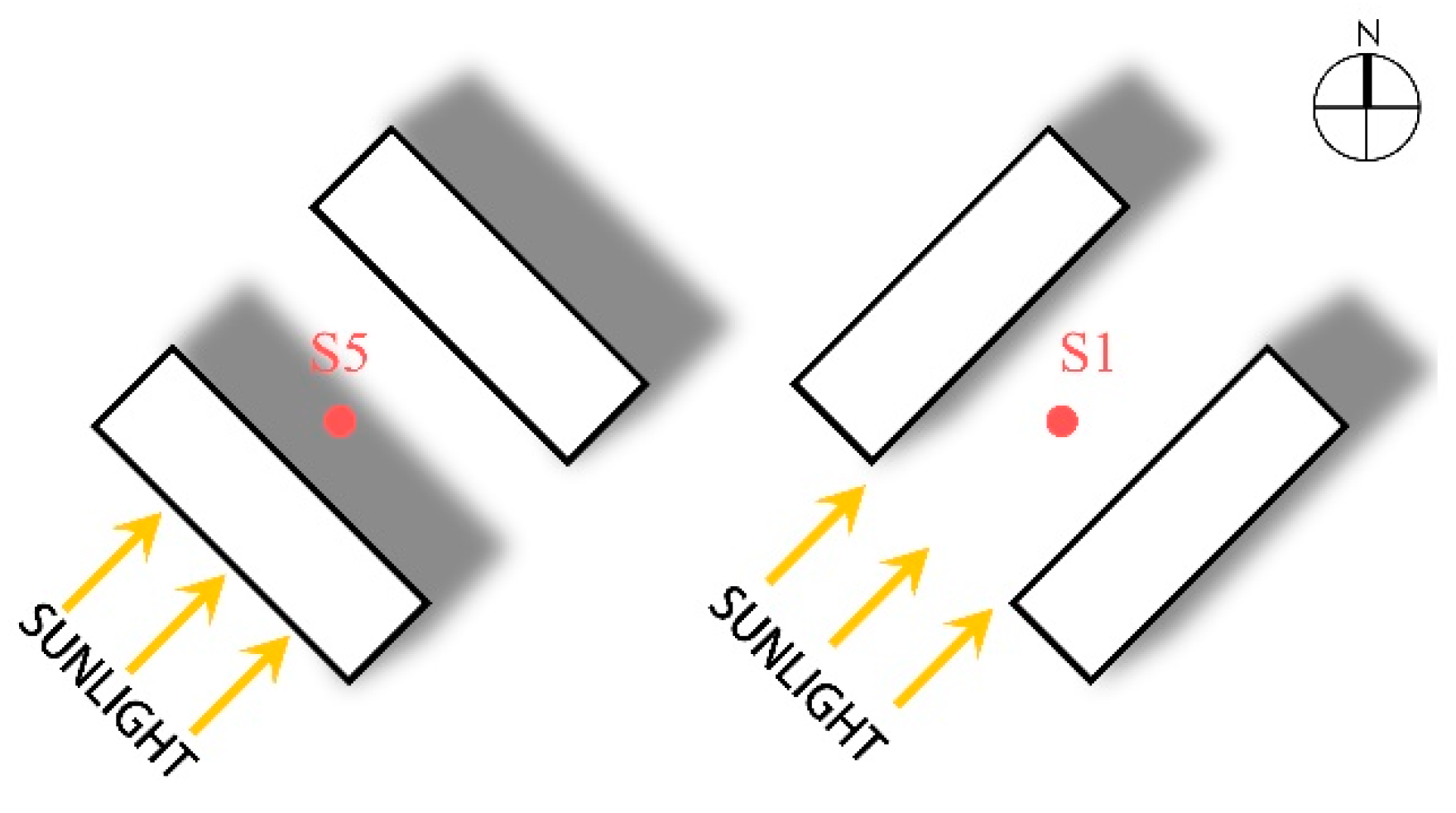
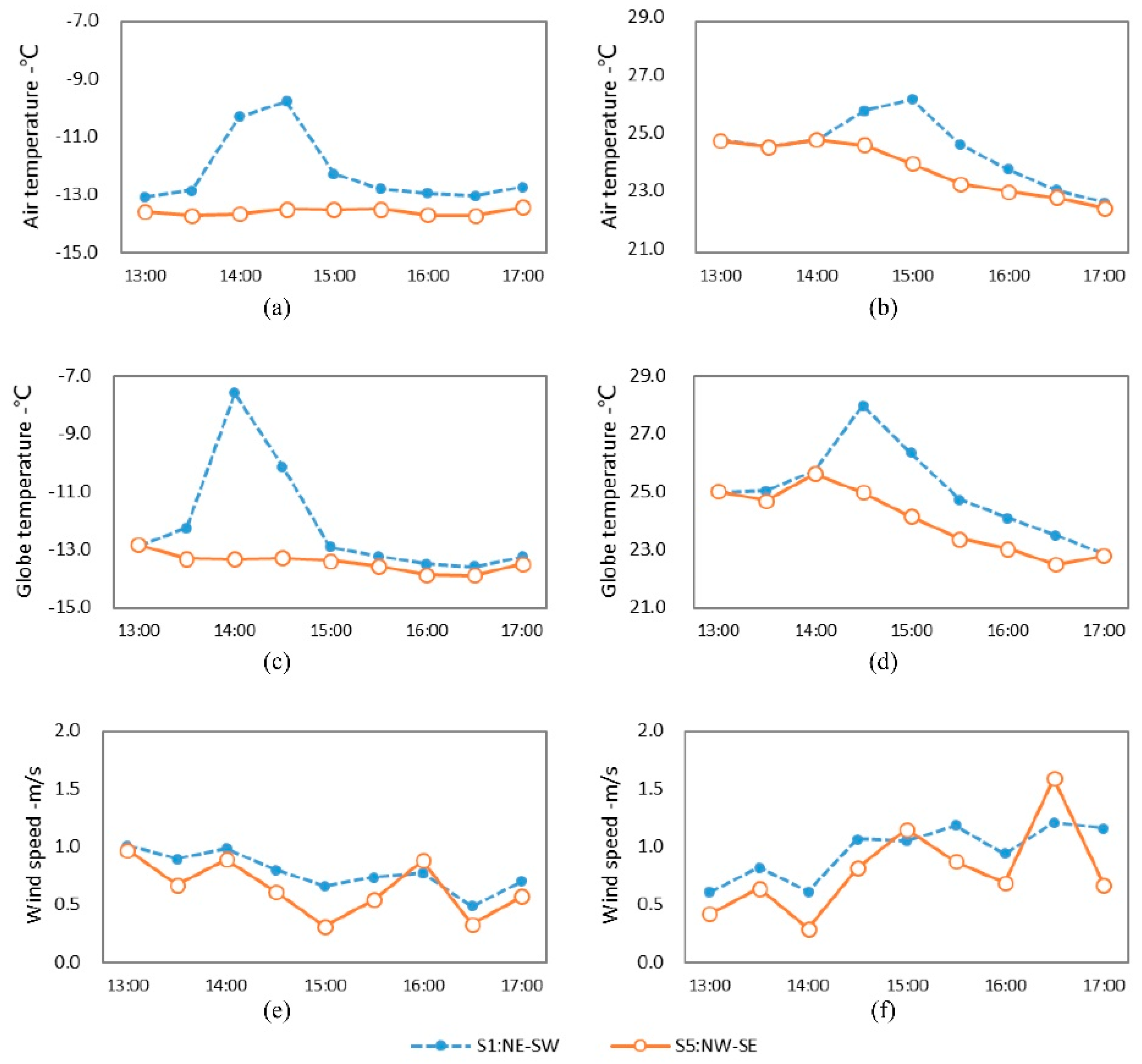
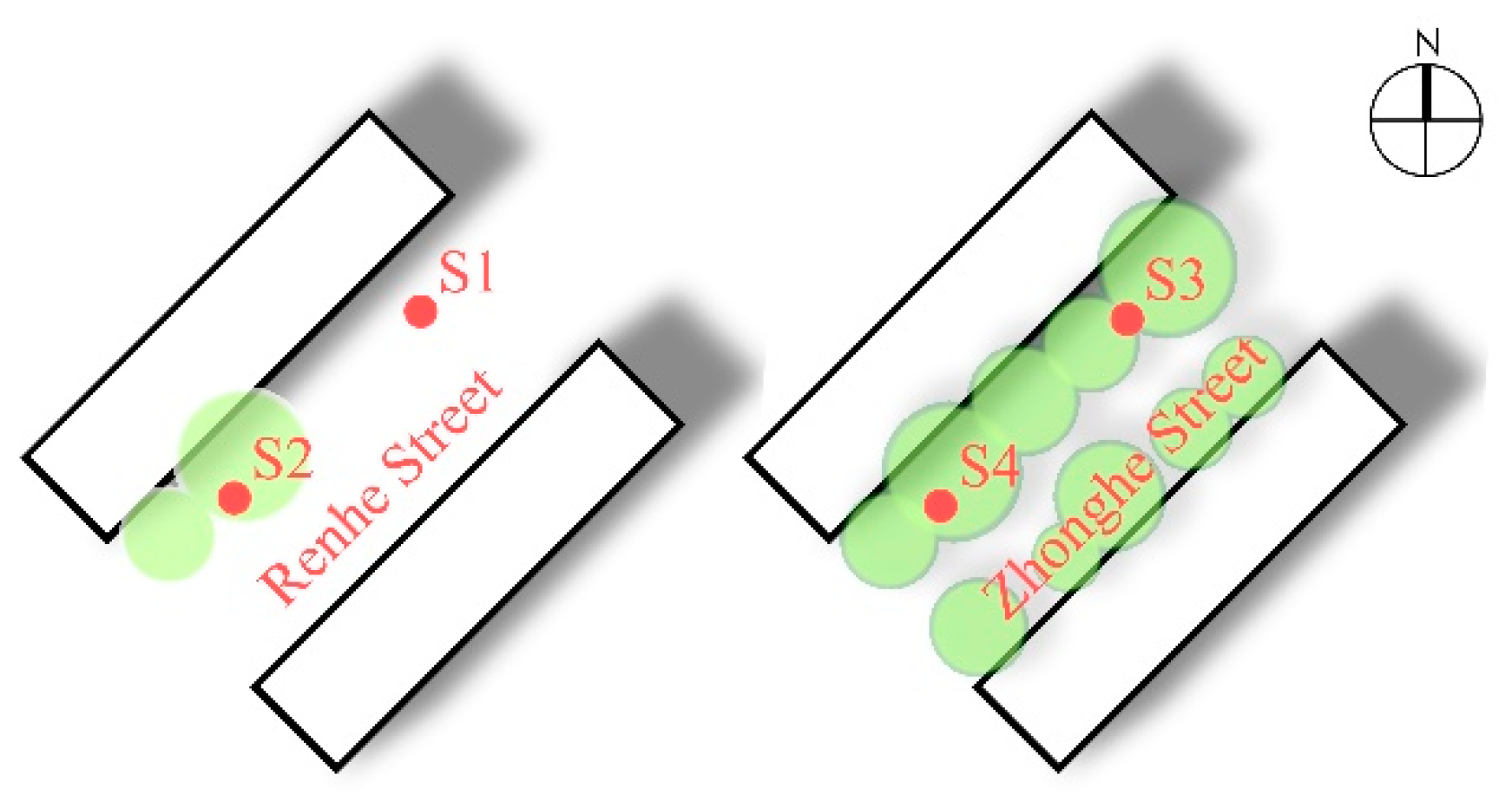
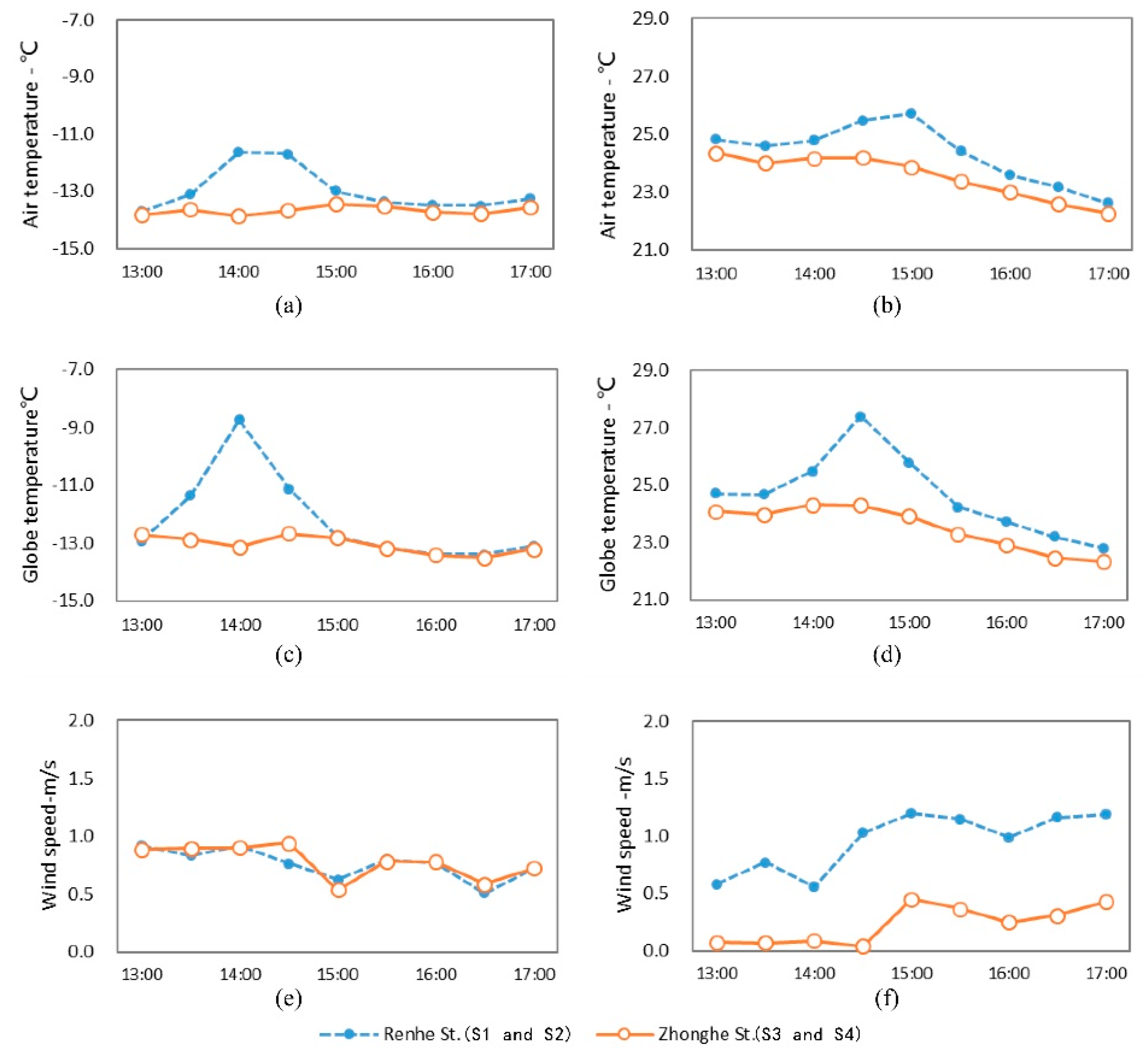
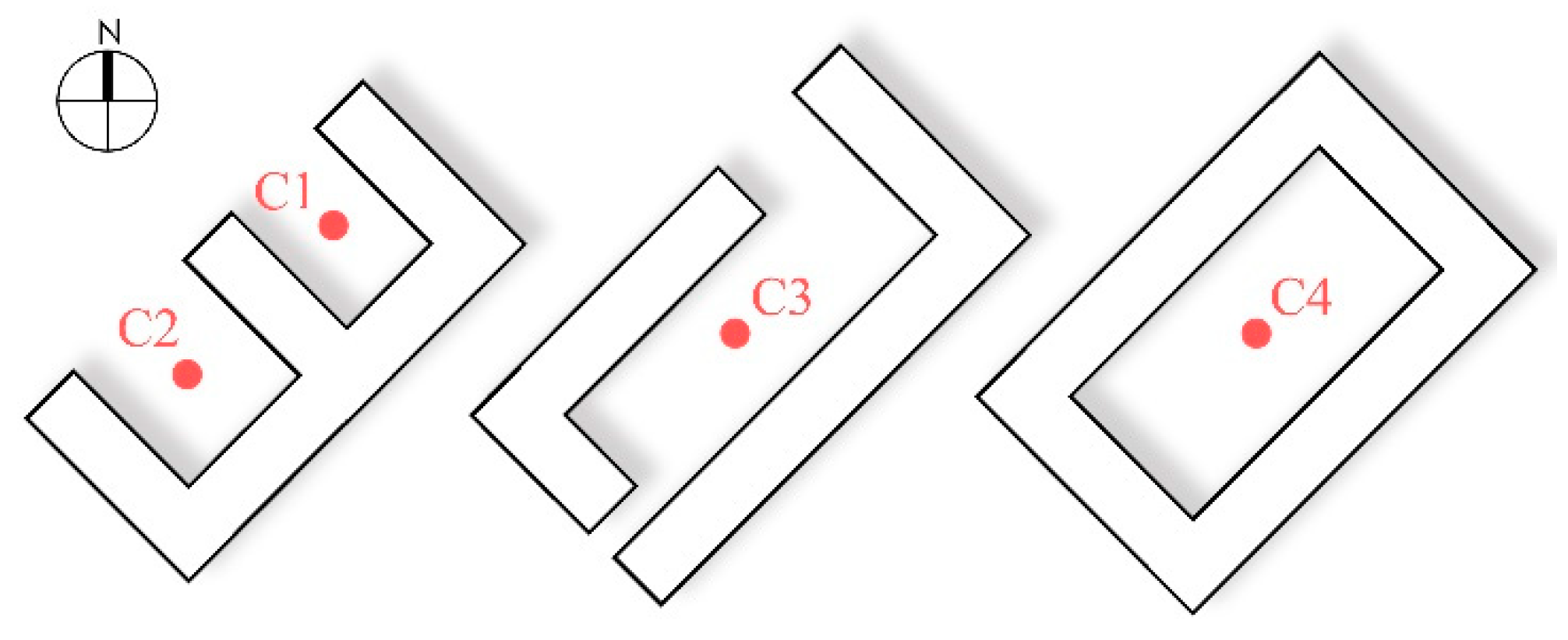
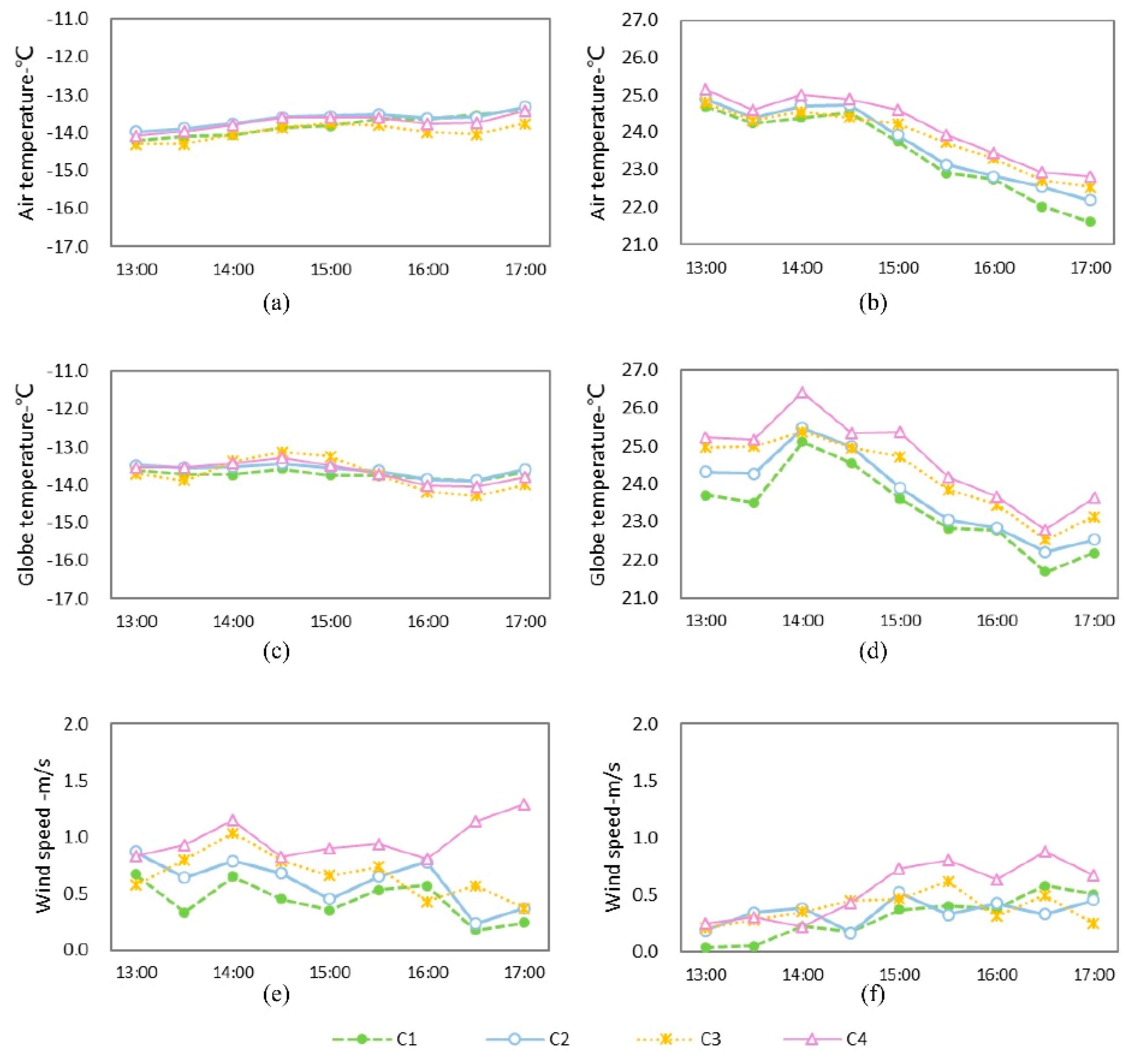
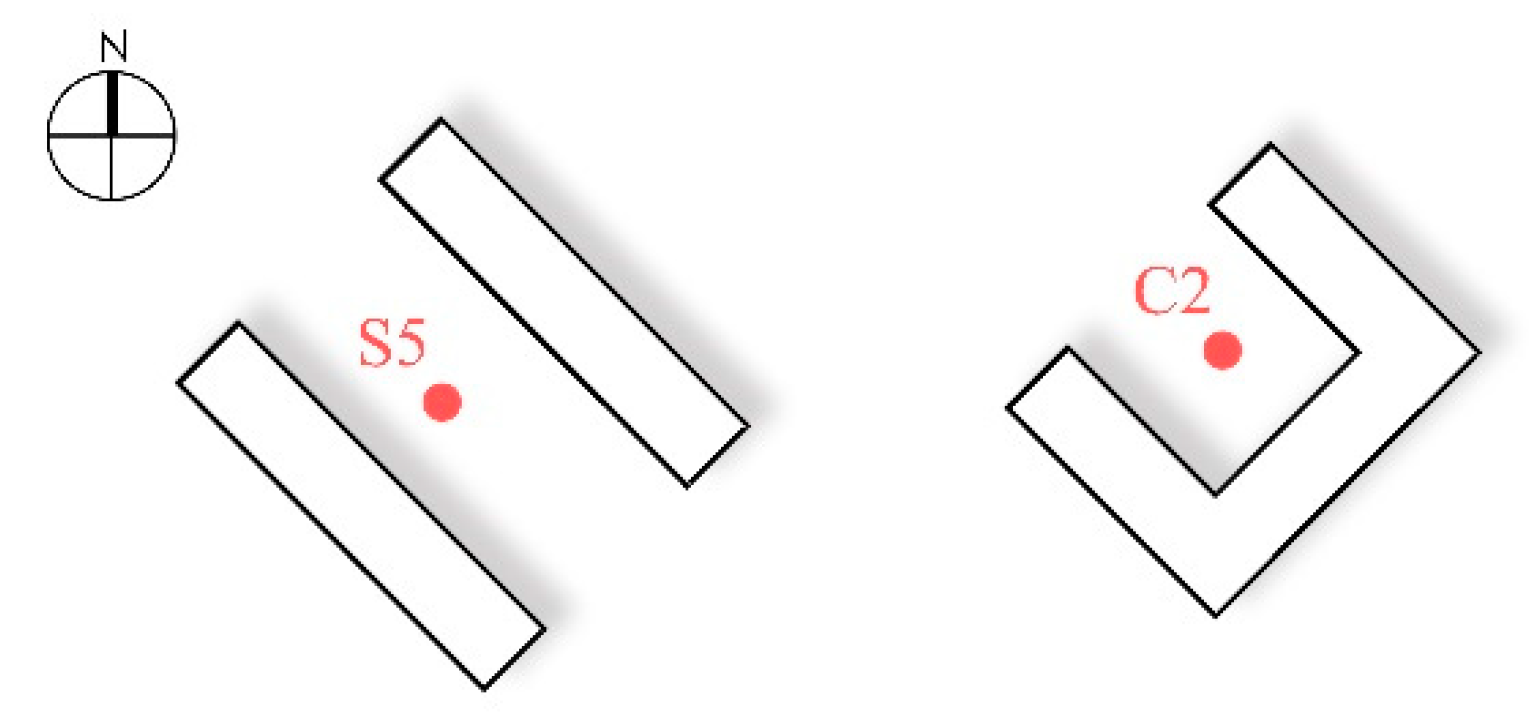
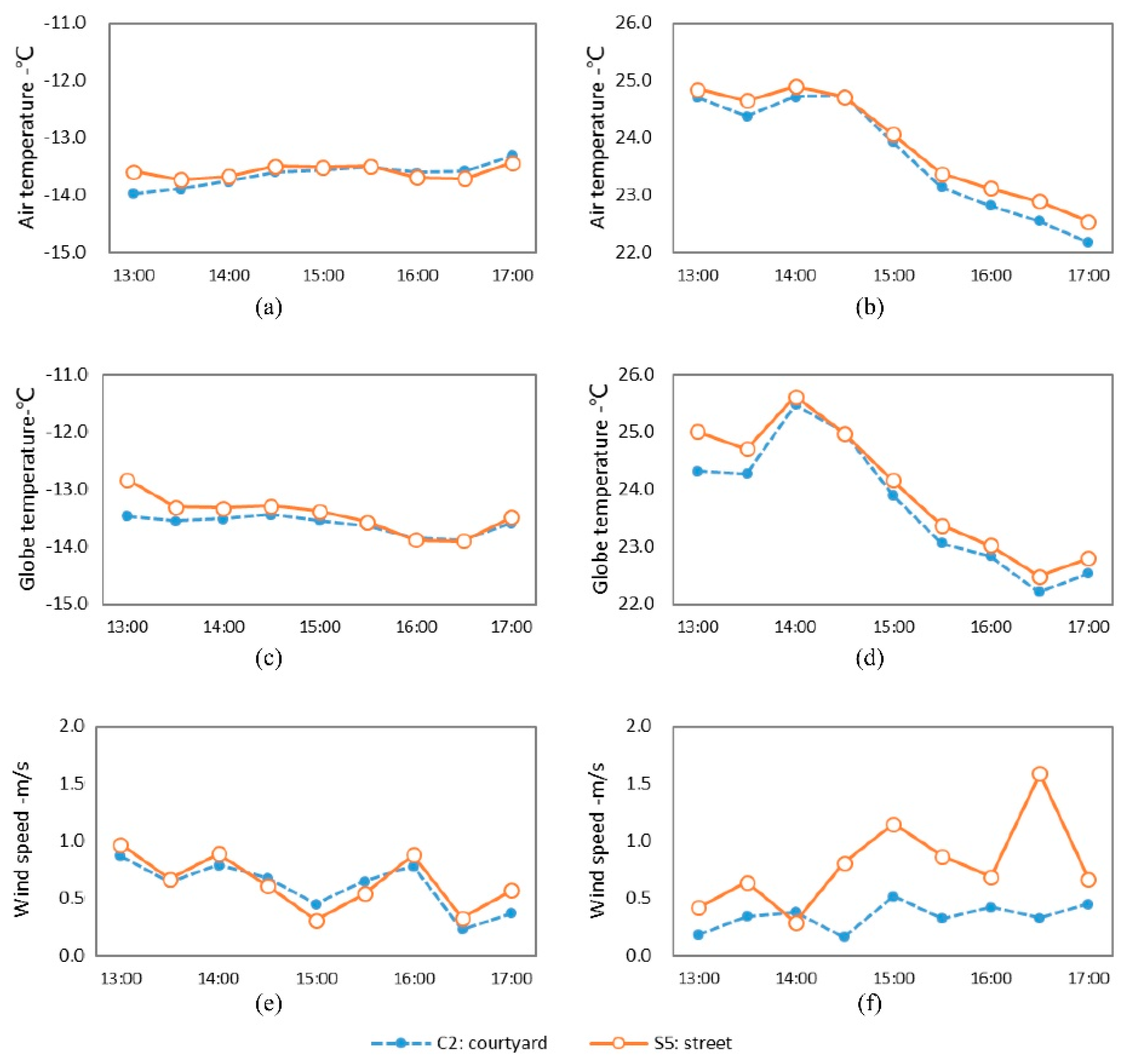
| Monitoring Site | Space | Street Orientation | Green Coverage Ratio | SVF * in Summer/Winter | Sunshine Duration in Summer/Winter(13:00–17:00) | Vegetation Description |
|---|---|---|---|---|---|---|
| S1 | Renhe St. | NE-SW | 0.00% | 0.26/0.26 | 1.5 h/1.5 h | none |
| S2 | Renhe St. | NE-SW | 13.65% | 0.12/0.19 | 1.5 h/1.5 h | Salix matsudana (Deciduous/H = 12 m/W = 7 m) |
| S3 | Zhonghe St. | NE-SW | 42.06% | 0.09/0.16 | 1.5 h/1.25 h | Salix matsudana (Deciduous/H = 12 m/W = 7 m) Syringa microphylla (Deciduous/H = 1.8 m/W = 2.4 m) |
| S4 | Zhonghe St. | NE-SW | 30.32% | 0.09/0.15 | 1.5 h/1.25 h | Salix matsudana (Deciduous/H = 12 m/W = 7 m) |
| S5 | Yonghe St. | NW-SE | 5.60% | 0.27/0.29 | 0 h/0.75 h | Syringa microphylla (Deciduous/H = 1.8 m/W = 2.4 m) |
| C1 | Courtyard | / | 0.00% | 0.22/0.23 | 0 h/0.5 h | none |
| C2 | Courtyard | / | 4.70% | 0.29/0.29 | 0 h/0.75 h | Syringa microphylla (Deciduous/H = 1.5 m/W = 2 m) |
| C3 | Courtyard | / | 11.87% | 0.30/0.33 | 0 h/2 h | Syringa microphylla (Deciduous/H = 1.5 m/W = 2 m) |
| C4 | Courtyard | / | 10.23% | 0.37/0.39 | 0 h/2.5 h | Syringa microphylla (Deciduous/H = 1.5 m/W = 2 m) |
© 2019 by the authors. Licensee MDPI, Basel, Switzerland. This article is an open access article distributed under the terms and conditions of the Creative Commons Attribution (CC BY) license (http://creativecommons.org/licenses/by/4.0/).
Share and Cite
Lin, Y.; Jin, Y.; Jin, H. Field Study on the Microclimate of Public Spaces in Traditional Residential Areas in a Severe Cold Region of China. Int. J. Environ. Res. Public Health 2019, 16, 2986. https://doi.org/10.3390/ijerph16162986
Lin Y, Jin Y, Jin H. Field Study on the Microclimate of Public Spaces in Traditional Residential Areas in a Severe Cold Region of China. International Journal of Environmental Research and Public Health. 2019; 16(16):2986. https://doi.org/10.3390/ijerph16162986
Chicago/Turabian StyleLin, Yujie, Yumeng Jin, and Hong Jin. 2019. "Field Study on the Microclimate of Public Spaces in Traditional Residential Areas in a Severe Cold Region of China" International Journal of Environmental Research and Public Health 16, no. 16: 2986. https://doi.org/10.3390/ijerph16162986
APA StyleLin, Y., Jin, Y., & Jin, H. (2019). Field Study on the Microclimate of Public Spaces in Traditional Residential Areas in a Severe Cold Region of China. International Journal of Environmental Research and Public Health, 16(16), 2986. https://doi.org/10.3390/ijerph16162986





